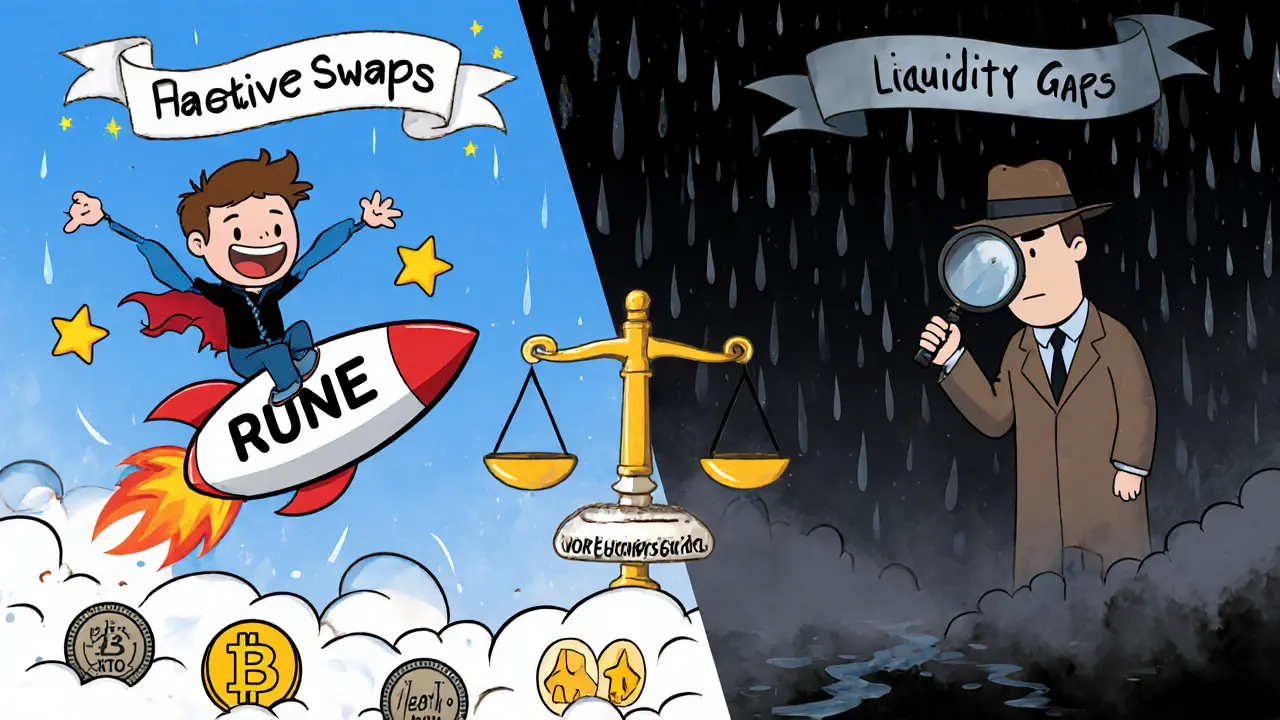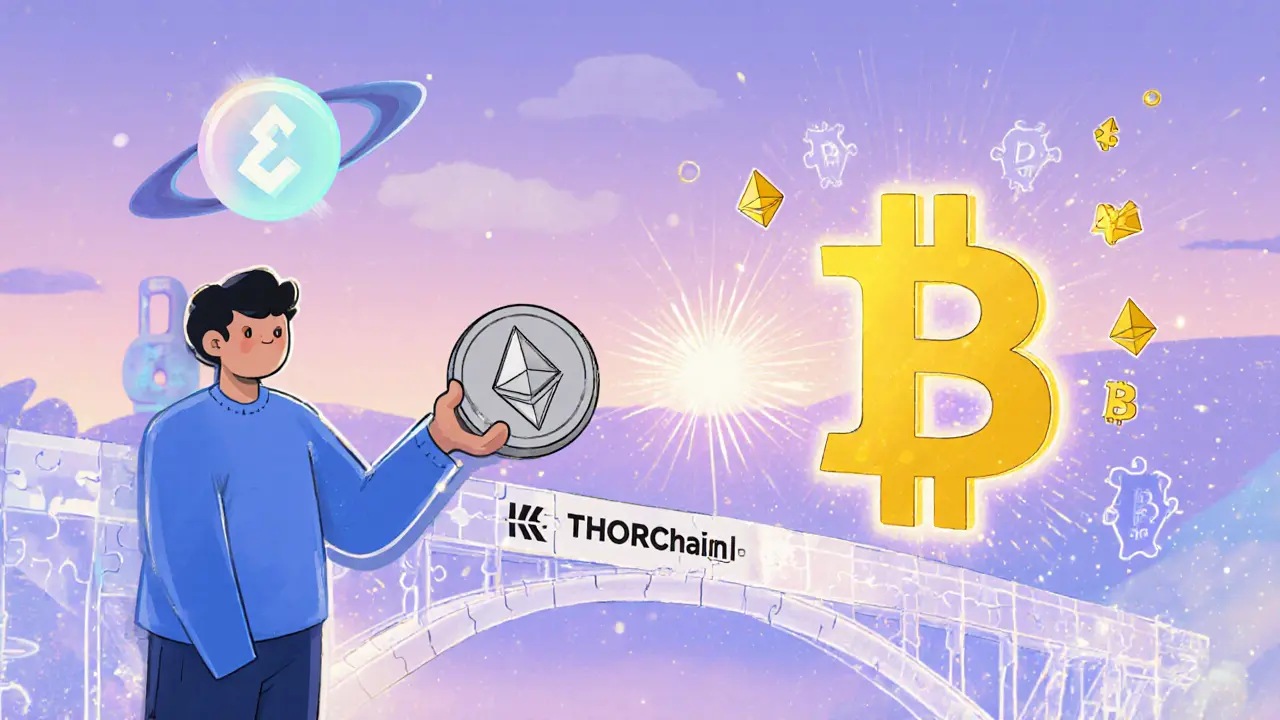THORChain Swap Fee Calculator
Fee Breakdown
About THORChain Fees
THORChain charges a 0.20-0.30% fee per swap, paid in RUNE. These fees are burned, creating a deflationary effect that can increase RUNE's value as network activity grows.
The fee structure helps fund the network's security and liquidity incentives, while maintaining a custody-free environment for users.
Ever wondered if you can swap Bitcoin for Ethereum without handing over custody to a centralized platform? THORChain is a decentralized cross‑chain liquidity network that promises exactly that, and it now runs on the Binance Smart Chain via the BEP20 standard. This review breaks down how the protocol works, what you’ll actually see on the front‑end, its security record, and whether the native RUNE token is worth a second look in 2025.
Key Takeaways
- THORChain enables truly native swaps (BTC↔ETH, LTC↔BNB, etc.) without wrapped tokens or KYC.
- Scalability claims of up to 10,000TPS, with daily peaks of 100,000 swaps.
- Security has improved since the 2021 hacks, but the platform was used to launder stolen ETH in Feb2025.
- RUNE sits at $1.21 (Oct2025) and is expected to rise to $1.50 by month‑end, driven by liquidity demand.
- Compared with Chainlink CCIP, Polkadot and Cosmos IBC, THORChain’s biggest edge is custody‑free native swaps.
How THORChain Works - The Tech Stack
The protocol is built on three core pieces:
- Tendermint is the consensus engine that powers fast finality.
- Cosmos SDK provides the modular framework for building the cross‑chain modules.
- THORChain uses a Proof‑of‑Bond system where validators lock up RUNE as collateral.
When you deposit a native asset (e.g., BTC) into a THORChain vault, the network’s leaderless vault manager records the inbound transaction, matches it with opposite‑side liquidity, and then executes an outbound swap on the destination chain. All swaps are settled in RUNE, which acts as the universal settlement layer.
The Incentive Pendulum dynamically shifts block rewards between validators and liquidity providers, keeping the network both secure and liquid.
Trading Experience - What You See on the Front‑End
THORChain does not host a branded UI; instead, a variety of front‑ends (e.g., Thorchain.org, TrustSwap, and several DeFi dashboards) connect to the same set of smart contracts. The user flow is uniform:
- Connect wallet: MetaMask, Trust Wallet, or any BEP20‑compatible wallet.
- Select assets: Choose any native token supported in the liquidity pools - BTC, ETH, BNB, DOGE, LTC, BCH, plus dozens of BEP20 coins.
- Enter amount: The UI shows real‑time price, slippage, and the RUNE fee (typically 0.20‑0.30%).
- Confirm: No KYC, no account creation. Your transaction is signed locally and broadcast to the relevant chains.
Because the protocol settles in RUNE, you’ll always see a small RUNE fee on both sides of the trade. The fee is burned, creating a deflationary effect that can boost RUNE’s price as volume grows.

Security Track Record - Risks & Improvements
THORChain’s anonymity‑first team has weathered two major incidents:
- 2021 exploitation: An attacker stole roughly $7M worth of assets via a compromised validator. The team responded by upgrading the Threshold Signature Scheme and adding additional monitoring.
- Feb2025 Bybit hack laundering: Stolen ETH was routed through THORChain to obscure provenance. The incident sparked community debate about AML compliance but did not expose a protocol flaw.
Since then, three security milestones have been introduced:
- Multi‑sig vaults that require consensus from a quorum of validators before moving funds.
- On‑chain anomaly detection that automatically freezes suspicious vaults.
- Regular third‑party audits (Quantstamp, PeckShield) with public reports.
While these measures raise the bar, the absence of formal regulation means users must perform their own due diligence.
RUNE Tokenomics & Price Outlook
RUNE is the linchpin of the ecosystem. Its roles include:
- Settlement asset: Every cross‑chain swap is routed through RUNE.
- Bonding collateral: Validators lock RUNE to secure the network.
- Governance: RUNE holders vote on protocol upgrades.
- Incentive driver: Liquidity providers earn RUNE rewards proportional to pool depth.
As of 3Oct2025, RUNE trades at $1.21 with a 14‑day RSI of 47 (neutral). The 50‑day SMA sits at $1.26, just below the 200‑day SMA of $1.39-suggesting a mild downtrend but plenty of room for a bounce if swap volume spikes.
Analyst consensus:
- CoinCodex projects $1.50 by 31Oct2025 (+23%).
- WalletInvestor’s range $1.57‑$11.04 for 2025 (highly optimistic).
- PricePrediction.net expects volatility in 2026, with a possible $3.34 target by 2030.
Bottom line: RUNE’s price is tightly coupled to network activity. If THORChain captures more cross‑chain swaps, demand for RUNE should rise.
Competition & Differentiators - How THORChain Stacks Up
| Feature | THORChain | Chainlink CCIP | Polkadot (XCMP) | Cosmos IBC |
|---|---|---|---|---|
| Native‑asset swaps | Yes (no wrapped tokens) | No (oracle‑driven) | Partial (relay tokens) | Partial (IBC‑enabled assets) |
| Custody‑free | 100% | Depends on bridge | Depends on parachain | Depends on hub |
| TPS (theoretical) | 10,000 (target 1M) | ~3,000 | ~2,500 | ~4,000 |
| Security model | Proof‑of‑Bond + Threshold Signatures | Oracle + smart contracts | Relay + shared security | Hub‑based validators |
| Regulatory exposure | None (decentralized) | Potentially higher (oracle reliance) | Medium (parachain governance) | Low (cosmos hub governance) |
THORChain’s biggest differentiator remains the ability to move native coins across chains without ever wrapping them. For power users who hate custodial bridges, that’s a compelling reason to choose THORChain over the others.
Pros & Cons - Quick Verdict
| Pros | Cons |
|---|---|
| True native swaps (no wrapped tokens) | Security incidents have hurt reputation |
| High theoretical throughput (10k‑TPS) | Liquidity can be thin on less‑popular pairs |
| No KYC, full custody remains with user | Regulatory gray‑zone; possible future restrictions |
| RUNE token benefits from network growth | RUNE price volatility adds extra risk |
| Incentive Pendulum balances rewards | Complex fee structure (swap fee + RUNE burn) |
If you value custody‑free swaps and are comfortable monitoring liquidity depth, THORChain is a solid addition to your DeFi toolbox. If you’re risk‑averse or need regulated compliance, you might look at more centralized bridges.

Frequently Asked Questions
Can I use THORChain without a wallet?
No. You need a crypto wallet that supports the native assets you want to swap (MetaMask, Trust Wallet, Ledger, etc.). The wallet signs the transaction locally before it hits the network.
What fees does THORChain charge?
Swaps incur a 0.20‑0.30% fee paid in RUNE, which is burned. There are no withdrawal or KYC fees.
Is THORChain regulated?
As of 2025, THORChain operates fully decentralized with no licensing or regulatory oversight. That means higher freedom but also higher personal liability.
How does RUNE’s price react to swap volume?
Higher swap volume drives more RUNE to be burned as fees, shrinking supply and potentially lifting price. Conversely, low volume can dampen demand.
Can I provide liquidity on THORChain?
Yes. You deposit a pair of native assets (e.g., BTC+RUNE) into a pool and earn a share of the swap fees plus RUNE rewards. Liquidity providers also stake RUNE to boost earnings.
Overall, the THORChain review points to a platform that delivers on its promise of native, custodial‑free swaps, but it still wrestles with security perception and liquidity depth. If you’re comfortable navigating a fast‑moving DeFi landscape, the upside-especially via RUNE’s tokenomics-could be rewarding.


What most people don’t realize is that THORChain’s open‑ended vault system is a perfect playground for hidden money‑laundering operations, especially after the February 2025 Bybit incident exposed how stolen ETH can be obscured through its cross‑chain pathways. The protocol’s lack of any KYC or regulatory oversight means that anyone with a basic wallet can funnel illicit funds across Bitcoin, Ethereum, and Binance Smart Chain without a paper trail. This isn’t just a theoretical risk; several peer‑reviewed papers cited THORChain as a “high‑risk conduit” in their AML analyses. The fee‑burn mechanism, while clever for tokenomics, also erases traces of the exact amount moved, making forensic accounting nearly impossible. As a result, the network attracts not only legitimate traders but also a shadowy cohort of crypto‑criminals who thrive on anonymity. If you value security, you should keep a healthy dose of skepticism before trusting your assets to a system that openly admits to being “custody‑free.”
One must, of course, approach the discourse surrounding THORChain with an intellectual rigor that transcends the pedestrian analysis typically offered by mainstream crypto aggregators; the superficial gloss that embellishes the platform’s purported “native‑swap” capability obscures a lattice of systemic inefficiencies that are, in the grand tapestry of decentralized finance, nothing short of a flamboyant yet fundamentally fragile edifice. To commence, the architecture’s reliance upon the RUNE settlement layer, whilst ostensibly elegant, introduces a latent vector of price volatility that cascades through every transaction, thereby imposing an inadvertent stochastic surcharge upon the end‑user- a nuance so subtle that only the most discerning connoisseur of tokenomics can appreciate its ramifications. Moreover, the purported scalability, heralded with hyperbolic claims of ten thousand transactions per second, remains an aspirational milestone rather than an empirically substantiated benchmark, as the extant test‑net data betrays a conspicuous discrepancy between theoretical throughput and observed latency under duress. The security narrative, sanitized by a litany of audits, nevertheless fails to grapple with the existential peril posed by the February 2025 laundering episode, wherein the protocol’s open vaults were exploited to obfuscate illicit Ether- a blemish that cannot be erased by mere code revisions alone. Adding to this mosaic of concerns is the governance model, which vestiges of a quasi‑centralized enclave of developers who, whilst cloaked in anonymity, wield disproportionate influence over protocol upgrades, thereby subverting the very ethos of decentralization they purport to embody. In sum, the allure of custody‑free swaps must be weighed against a constellation of latent risks that, if unmitigated, could precipitate a systemic erosion of trust and, ultimately, a market correction that will reverberate far beyond the RUNE price trajectory.
I see the value in true native swaps, but the liquidity on some of the less popular pairs can feel thin, which may lead to higher slippage for everyday users.
Indeed, the mathematical underpinnings of THORChain’s Proof‑of‑Bond mechanism warrant a thorough examination, particularly with respect to the collateralization ratio required of validators. By ensuring that each validator locks a sufficient quantity of RUNE, the protocol mitigates the risk of malicious behavior while simultaneously aligning economic incentives. Nonetheless, the dynamic nature of RUNE’s market price introduces a variable exposure, necessitating continuous monitoring of the bond‑to‑value relationship. In practice, this translates to a need for periodic re‑bonding or top‑ups, a nuance that may be overlooked by participants unfamiliar with stochastic asset management. Consequently, while the security model is robust in theory, its implementation demands vigilant stewardship from all network participants.
Oh sure, because nothing screams “trustworthy” like a platform that glorifies “custody‑free” while secretly moonlighting as the crypto world’s favorite money‑laundering lounge. The only thing more dazzling than the RUNE burn is the way THORChain proudly wears its lack of regulation like a badge of honor, as if saying “we’re so avant‑garde we don’t need any pesky compliance.” If you enjoy watching your assets disappear into a black hole of anonymity, then by all means, hop aboard the THORChain express- destination: bewilderment.
Just remember to bring your own conspiracy theory, because the network’s security “improvements” are about as convincing as a plot twist in a low‑budget sci‑fi flick.
Hey, if you’re looking for a fresh way to swing crypto around without a middleman, THORChain is pretty slick- just connect your wallet, pick the assets, and watch the trade happen. The fees are low, and the RUNE burn actually helps the token’s value over time. Give it a try, you might end up liking the freedom!
Swapping native coins directly does sound convenient, though I’ve noticed that the pool depth for rare pairs can be shallow, which sometimes results in a noticeable price impact.
The purported merits of THORChain are, upon rigorous scrutiny, tantamount to an elaborate façade constructed to veil its inherent vulnerabilities. The protocol’s reliance on a singular settlement token, RUNE, engenders a monolithic exposure that is antithetical to the diversification principles extolled by prudent financial doctrine. Moreover, the historical ledger of security breaches-most notably the 2021 exploitation and the 2025 laundering conduit-exposes a systemic incapacity to preclude malicious actors, thereby eroding any semblance of trustworthiness. The ostensible “decentralization” is, in effect, a thin veneer that fails to insulate participants from systemic risk, rendering the platform unsuitable for risk‑averse investors.
While it’s easy to dismiss THORChain as a wild west of unregulated swaps, there’s an undeniable charm in its dedication to truly native cross‑chain moves-no wrapped tokens, no custodial middlemen. That said, the occasional thin liquidity and the occasional headline about illicit use do warrant a measured dose of caution. So, if you’re comfortable monitoring pool depths and keeping an eye on the news, you can enjoy the freedom without getting caught up in the drama.
Nice rundown! I’m excited to see how RUNE performs as the network grows.
Meh.
There’s a lot to love about THORChain’s vision, especially the ability to move assets without surrendering custody, but the reality of thin liquidity and occasional security headlines keeps me on my toes. I think it’s a promising piece of the DeFi puzzle, provided users stay informed and diversify their exposure.
Ah, the drama of decentralized finance, where every token swap is a theatrical performance, every fee a whispered secret, and every audit a chorus of applause, yet behind the curtains lurks the stark reality of market volatility, regulatory uncertainty, and the ever‑present specter of exploitation.
From a protocol‑level perspective, THORChain’s integration of Tendermint consensus with Cosmos SDK modules facilitates a modular state machine that optimizes for cross‑chain atomicity, albeit at the cost of increased inter‑module latency during peak throughput scenarios.
In my opinon, the article fails to captuer the nuanced interplay betwen tokenomics and user experience, omitting the subtle yet crucial impact of gas fees on BEP20 transactions.